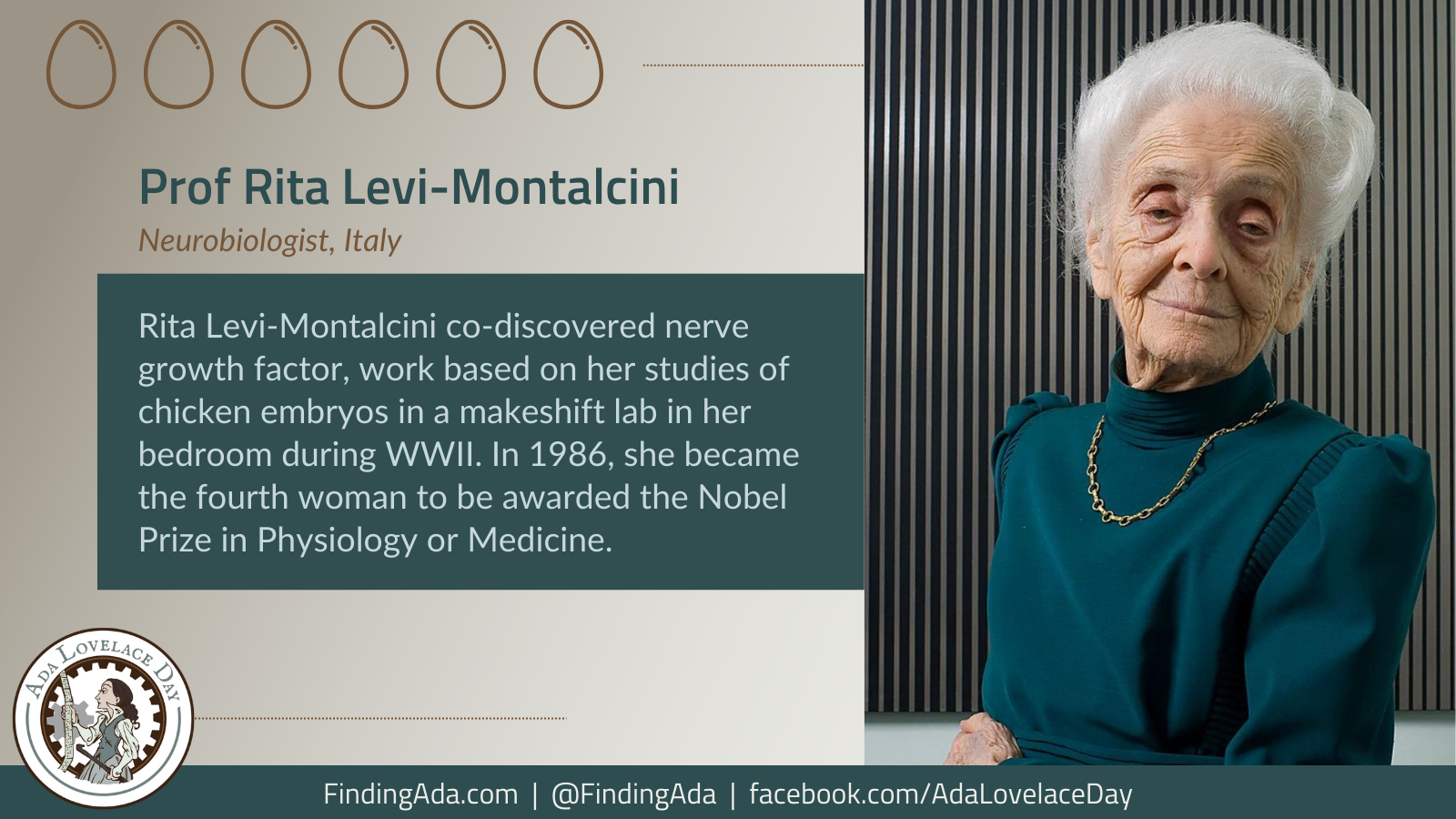Professor Rita Levi-Montalcini
Rita Levi-Montalcini was a neurobiologist who discovered nerve growth factor in collaboration with her colleague, Stanley Cohen. They were both awarded the Nobel Prize in Physiology or Medicine in 1986, and Levi-Montalcini became only the fourth woman to be awarded the prize.
Levi-Montalcini was born in Turin in 1909. She graduated summa cum laude from the University of Turin Medical School in 1936, staying there to investigate the development of the nervous system. But she lost her job just two years later when Mussolini banned Jews from academic and professional careers.
Unable to officially work, she began buying fertilised eggs and studying chicken embryos in a laboratory that she set up in her bedroom, working in “primitive conditions”. She focused on understanding how nerve fibres grow in the embryos’ wings using microsurgical instruments she made herself from tools such as sewing needles and watchmakers’ tweezers. As the Guardian reported in her obituary, “many of the experiments could be eaten when they were finished.”
In 1943, she and her family fled to Florence, where they were protected from the Nazis by non-Jewish friends. After the war, they returned to Turin and in 1946, she moved to the US to take up a short term position at Washington University in St Louis, in Missouri. She successfully duplicated the experiments she’d done in her bedroom, and was offered a research associate position. She stayed at the university for 30 years.
In 1952, Levi-Montalcini grafted mouse tumour tissue onto chick embryos, and discovered that the cancerous tissues caused the rapid growth of nerve fibres. Somehow the tumour was encouraging nerve fibres to grow. She isolated a protein that she called nerve growth factor (NGF) from these cancerous tissues. This was painstaking and difficult work, but its importance to embryology and oncology was clear.
She became a professor in 1958 and four years later established a second lab in Rome, splitting her time between Italy and the USA. She became the director of the Research Centre of Neurobiology of the CNR (Rome), and then became director at the Laboratory of Cellular Biology of the Italian National Council of Research. In 2001 she became an Italian senatore a vita, or senator for life, able to sit in the Italian upper house of parliament. In 2002, she founded and later became president of the European Brain Research Institute.
She died in 2012, aged 103.
Further Reading
- Rita Levi-Montalcini, Wikipedia
- Rita Levi-Montalcini, Nobel Prize
- Celebrating life with Rita Levi-Montalcini: A hundred years and more, Sanjay Kalra, Manash Baruah and Ambika Gopalakrishna Unnikrishnan, Indian Journal of Endocrinology and Metabolism, May-June 2012
- Italian Nobel laureate Rita Levi-Montalcini dies, BBC, 30 December 2012
- Rita Levi-Montalcini obituary, Anthony Tucker, The Guardian, 30 December 2012
- Finding the Good in the Bad: A Profile of Rita Levi-Montalcini, Marguerite Holloway, Scientific American, 30 December 2012
- Rita Levi-Montalcini, Geoff Watts, The Lancet, 26 January 2013
- Rita Levi-Montalcini: NGF, the prototypical growth factor, Nicholette Zeliadt, PNAS, 14 March 2013
- Rita Levi-Montalcini: Neuroscientist par excellence, Leslie Lars Iversen, PNAS, 14 March 2013
- Women in Science: Rita Levi-Montalcini (1909-2012), Dr Ellen Elliott, The Jackson Laboratory, 25 April 2017
- Five facts about Rita Levi-Montalcini, who figured out how neurons grow, Lauren Mackenzie Reynolds, Massive Science, 15 March 2018
- Why Are We Scientists? Drawing Inspiration From Rita Levi-Montalcini, Francesca Malerba, Frontiers in Cellular Neuroscience, 21 January 2022
